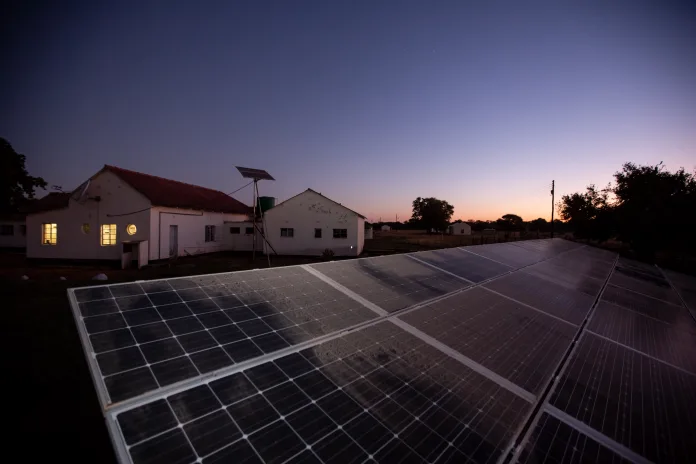By Johnson Siamachira
Harare, (New Ziana) – In a dimly lit delivery room at Mhandamabwe Rural Health Centre in Masvingo, Petunia Tshuma held her breath as she prepared to bring new life into the world.
Just a year ago, expectant mothers faced the daunting prospect of childbirth under candlelight, relying on flickering flames to illuminate the delicate process.
“We used to ask mothers to bring candles and torches,” Tshuma, a nurse, recalls, her voice tinged with relief. “Now, with solar power, everything has changed.”
The Solar for Health (S4H) initiative, championed by the United Nations Development Programme (UNDP) and the Ministry Of Health and Child Care, and funded by the Global Fund, aims to illuminate healthcare facilities across Zimbabwe, ensuring that no mother delivers in the dark again.
Launched in 2017, S4H has installed solar power systems in over 1,000 health facilities, transforming the way healthcare is delivered in some of the country’s most remote areas.
As Zimbabwe grapples with a healthcare system plagued by power shortages, the S4H initiative emerges as a beacon of hope. By harnessing solar energy, the programme not only enhances maternal and child health but also strengthens the overall healthcare infrastructure, ensuring that essential services run seamlessly even during national power outages.
Zimbabwe’s healthcare system has long suffered from unreliable electricity, leading to frequent disruptions in essential services. According to the World Health Organization, 25 per cent of health facilities in sub-Saharan Africa lack access to electricity, while many others face prolonged interruptions.
In Zimbabwe, the situation has reached critical levels, particularly in rural clinics where power cuts can last up to 18 hours a day.
The S4H initiative aims to address these challenges by installing solar panels and energy storage systems in health facilities.
These installations power vital services, including cold chains for vaccines and life-saving medical equipment. “Frequent power outages disrupt critical operations,” says Dr. Douglas Mombeshora, Minister of Health and Child Care. “With reliable energy, our health facilities can maintain continuous operations.”
The numbers speak volumes. With S4H’s support, 447 health facilities now have solarised boreholes, improving access to clean water.
The project has resulted in a remarkable reduction in operational costs, as facilities save up to 60 per cent on electricity bills. “This allows us to reinvest the money saved into improving services,” says Judith Chamboko, Nurse in Charge at Nemwana Clinic in Masvingo.
“Even when Binga was hit by floods in 2023, and I had just given birth, and the electricity went out for two weeks, we still got vaccines for my third child because the solar battery-powered fridges kept humming at our clinic and our meds were fresh,” said Agnes Muchimba, a mother and part-time volunteer at Sinakatenge Clinic in Binga.
Beyond cost savings, the initiative directly impacts patient care. “We can now vaccinate patients daily without interruptions,” says Shingirai Mukonoweshuro, a nurse at Mazebe Clinic in Kwekwe district. “Before solar power, we struggled to keep vaccines from spoiling during outages.”
The S4H initiative not only tackles energy poverty but also addresses gender inequalities. By training women as solar technicians, the project empowers local communities while advancing gender equality. “We see renewable energy as a powerful tool for inclusion and development,” says a UNDP representative.
Moreover, the initiative supports Zimbabwe’s broader goals, including Sustainable Development Goals (SDGs) on health, gender equality, and climate action. “Solar energy is the bridge to achieving universal health coverage,” says Dr. Ayodele Odusola, UNDP Resident Representative in Zimbabwe.
Despite these successes, challenges remain. Zimbabwe’s economy faces significant hurdles, including high inflation and a lack of investment in infrastructure. While the S4H initiative has installed solar systems in over 1,044 health facilities, a comprehensive maintenance plan is still in development to ensure these systems operate effectively over their lifespan.
As the government works towards a complete solarisation of health centres, there is hope for a future where no mother has to fear delivering her child in the dark. “This initiative has revitalised our health facilities,” says Nkosilathi Mulinane, Nurse in Charge in Gokwe North district. “We can now perform outreach services and have raised our coverage from 70 per cent up to 101 per cent.”
The Solar for Health initiative symbolises a transformative leap towards an integrated approach to healthcare and energy in Zimbabwe. By providing reliable access to clean energy, the project not only enhances healthcare delivery but also fosters economic growth and social empowerment. As Zimbabwe continues to harness its abundant solar resources, the vision of a healthier, brighter future becomes increasingly achievable.
Tshuma sums it all up: “The flick of a switch can change lives.” With solar power illuminating the path forward, Zimbabwe is lighting up lives, one health facility at a time.”
New Ziana



